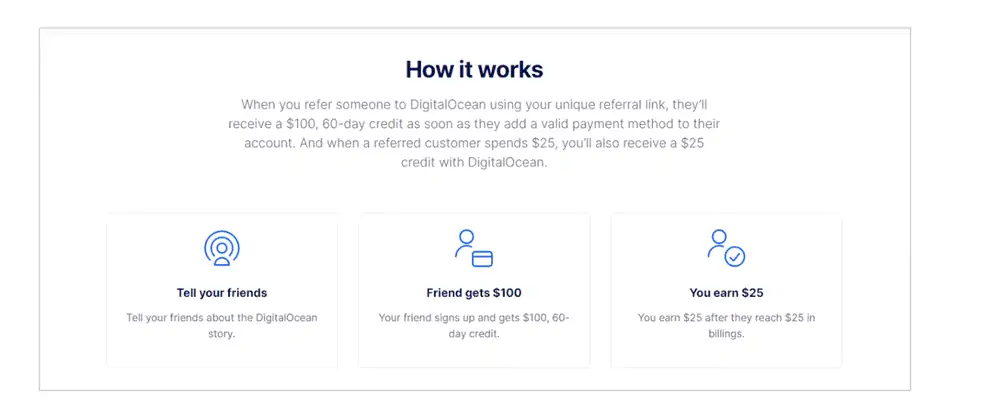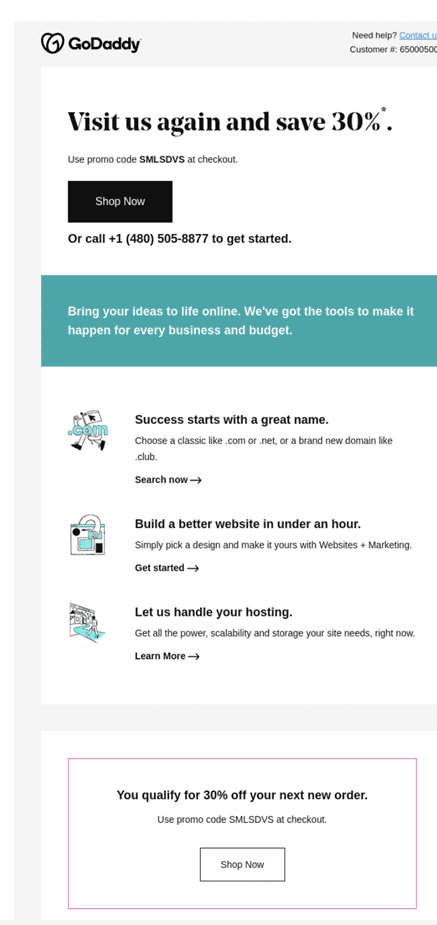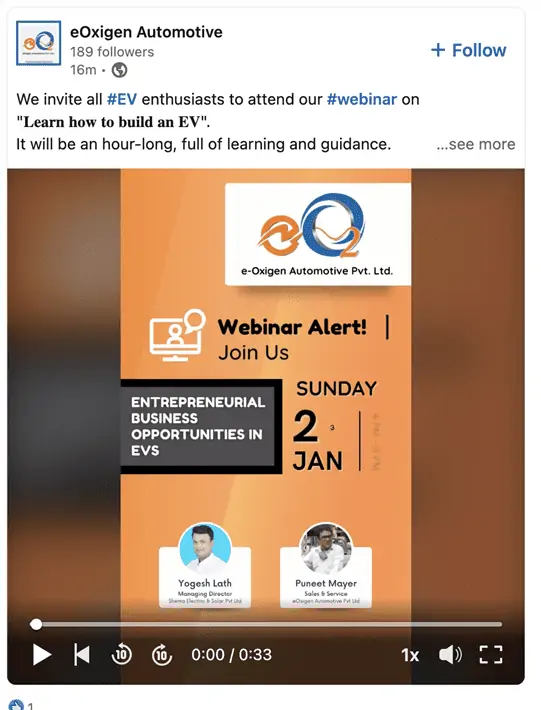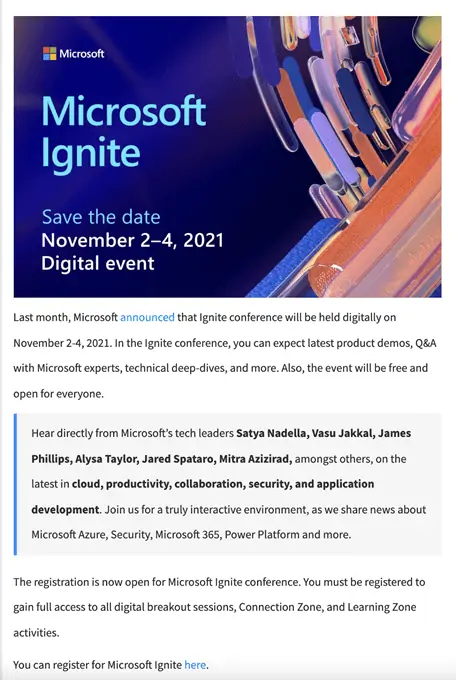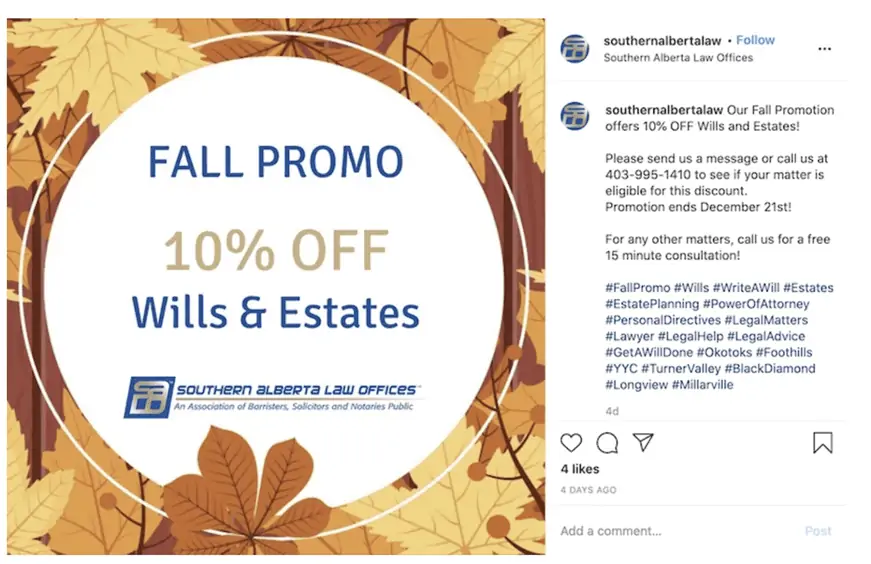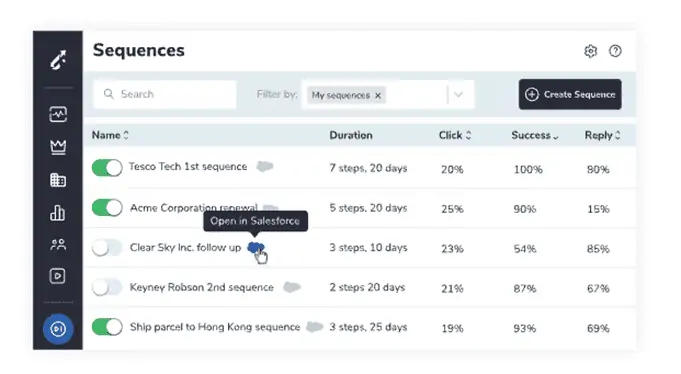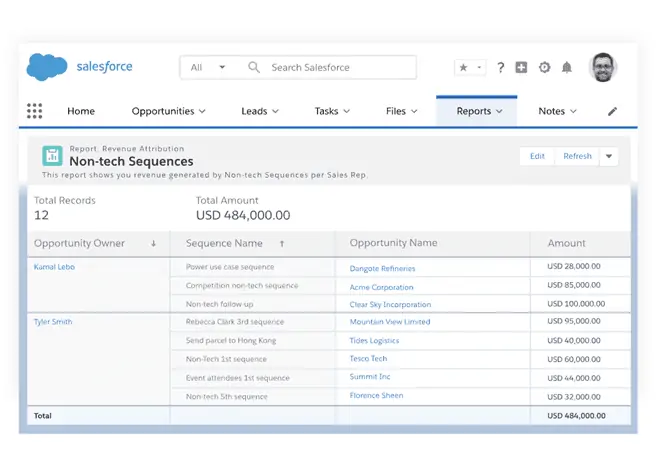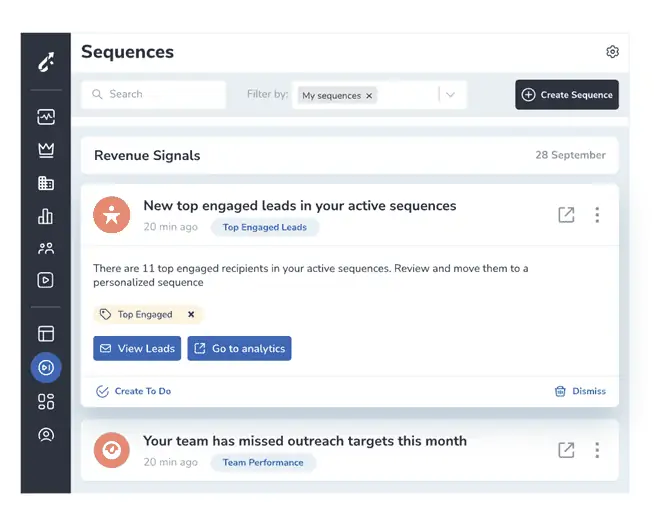From buy one, get one (BOGOs) and bundles to coupons, rewards programs, and giveaways, chances are, you scroll past hundreds of sales promotions each day. They’re in your inbox, embedded in your social feeds, and on-display at your local supermarket.
While there’s a lot you can learn from the best B2Cs in the game, B2B promos support different goals – and thus require a different approach.
In these next few sections, I’ll define “sales promotions” and explain the pros and cons that come with the territory. Then, I’ll share some examples and best practices to help you build your own promotion strategy.
What is Sales Promotion?
A sales promotion is a temporary or time-sensitive campaign designed to increase demand, generate interest, or encourage consumers to try a product or service.
Sales promotions come in many forms and support a long list of objectives. You might use them to attract new customers, boost retention rates, offload inventory, or deepen your relationship with existing clients.
That said, all sales promotions point back to the bottom line — and at the end of the day, the goal is to increase sales.
Sales promotion advantages
The importance of sales promotion goes beyond quick wins and a pipeline full of leads. The best strategies span the entire sales funnel and focus on very specific goals based on where buyers are in their journey.
A few examples:
- Bring in new customers. Attract new customers with discounts, free trials, or free products. Ideally, they’ll fall in love with your solution and become a loyal customer.
- Launch products or service offerings. Allowing customers to try out new solutions at a reduced rate can help you lock in the positive reviews and word-of-mouth recommendations that attract a wider audience.
- Offload inventory—fast. Many companies use promotions to get rid of aging inventory—whether that’s due to seasonality, poor performance, or a last-minute push to hit sales targets at the end of the quarter.
- Boost long-term loyalty. Sales promos help you nurture relationships with loyal customers, keeping them happy, engaged, and informed about upcoming releases & updates. Targeted sales promotions for existing customers can demonstrate appreciation and incentivize repeat purchases.
Sales promotions can also encourage repeat purchases by offering exclusive deals or rewards to current customers.
There’s a lot more where that came from. But, the point is, sales promotions can benefit the bottom line as much as the actual buyers.
Disadvantages of Sales Promotions
It’s important to note that many of the “disadvantages” associated with sales promotions are really just “strategic missteps.”
Sales promotions are generally a net positive for both business and consumer.
It’s just that there’s a lot that can go wrong if you say, make campaign decisions using incomplete or inaccurate data or fail to put customer needs first.
Potential disadvantages include:
- Hidden costs
- Price sensitivity
- Alienates customers
- Limits revenue
There’s also the risk of falling into a “sales promotion trap,” where discounting is the only way to reliably close deals.
The idea is, if you run too many promos, customers expect them – and eventually, will only buy from you when you’re running a promotion.
What happens is, you get caught in a cycle where you’re forced to invest in short-term discounting strategies, at the expense of long-term growth.
Risks and Challenges of Sales Promotions
Sales promotions can be a powerful tool for driving immediate sales and attracting new customers, but they come with their own set of risks and challenges. One significant risk is the potential for cannibalizing future sales. If customers become accustomed to frequent discounts and promotions, they may delay purchases, waiting for the next deal. This behavior can lead to a decrease in regular sales and revenue over time, as customers only buy during promotional periods.
Another challenge is the creation of price expectations. When a business frequently offers discounts, customers may start to perceive the discounted price as the standard price. This can make it difficult to sell products at full price in the future, ultimately squeezing profit margins and undermining the business’s pricing strategy.
Moreover, poorly executed sales promotions can damage a business’s brand image. If a company appears to be constantly offering discounts, it may be perceived as desperate or struggling, which can erode customer loyalty and trust. To avoid these pitfalls, it’s crucial to plan promotions strategically, ensuring they add value without compromising long-term goals.
Sales promotion examples from real B2Bs
As mentioned, sales promotions align with your sales process, business objectives, and most crucially, the touchpoints in the buyer’s journey. Evaluating the return on investment (ROI) of sales promotion activities is essential to understand whether these promotions yield sufficient returns.
Again, it can be tricky to track down examples of B2Bs really nailing it on the sales promotions front.
So, to help you out, I’ve included a few examples of how real B2Bs use sales promotions “in the wild” to support different goals:
Loyalty
Loyalty programs aren’t just for retailers and restaurants, they’re a great way to re-engage existing B2B customers so they keep coming back.
Loyal customers spend close to 70% more than new customers and account for about 80% of total sales. So, naturally, it’s in your best interest to keep them happy for the long haul.
Keep in mind, rewards need to provide value to members. Instead of offering discounts or freebies, consider offering perks like member events, exclusive workshops or training sessions, or early access to new products.
You might even offer deals on complementary products (though, in this case, you’ll need to set up joint partnerships with other brands in your niche).
Trial offers
Trial offers are pretty standard fare in the SaaS/software industry. They give you a chance to prove the value of your solution before the buyer commits to a contract or monthly payment.
If you’re targeting existing customers, you might offer personalized training or 1:1 demo to sweeten the deal. That way, you can demonstrate how the new product solves their specific problem or extends the value of their current solution.
Alternatively, you might offer a money-back guarantee as Avast does in the example below. This gives users the chance to spend more time using the solution to see if it’s truly a fit. If they like it, they’re already up-and-running. But if not, they can cancel and move on – no big deal.
Referral programs
Referral programs allow you to leverage existing relationships to bring in new customers – many of whom won’t spend as much time evaluating solutions
And at the same time, referral programs give your current customers a chance to save money or access exclusive rewards.
As an example, here’s a look at Digital Ocean’s referral program:
The program is pretty straightforward.
Current customers get a link to share with friends or colleagues. When a friend signs up, they receive a $100 credit to their account and the current customer pockets $25.
While the promotion is ongoing, signup credits expire after 60 days. The time limit is a gentle nudge to encourage adoption among new users – without applying too much pressure.
Discounts
Discounting definitely shouldn’t be the primary focus of your sales promotion strategy. However, there are some situations where it’s an effective tool for convincing customers to take the next step.
For example, you might try something like this GoDaddy email, and offer a sign-up discount to lock down new users.
This example from Zapier does a nice job tapping into a sense of urgency – offering a 30% discount on paid plans to existing users.
While each example targets a different stage in the customer journey, both make a point of emphasizing the benefits buyers stand to gain by taking action.
It’s not just, “here’s 30% off.” It’s, “here’s 30% off – but also, here are some reasons why this is a really great deal.”
These offers don’t sound like a desperate attempt to win customers. The tone feels more like the brand is doing the buyer a favor or giving them insider info.
Event-based promotions
Events like trade shows, conferences, even high-profile virtual experiences are often great opportunities to run sales promotions.
Many times, B2Bs use events to showcase new products or reach new audiences, while buyers often attend to meet with suppliers or evaluate solutions.
This example from a LinkedIn Groups feed promotes a virtual event for EV entrepreneurs. The primary focus here is driving registrations by highlighting the value of the webinar content.
You might want to hold off and mention the promo during the event – presenting it as a potential solution or a complement to the topics you covered during your session.
Or– you could potentially follow a similar approach– weaving a product launch announcement or special offer into the video.
Note that this tends to work best in cases where your audience is anticipating a big announcement.
For example, here’s a press release for Microsoft’s November 2021 Ignite Conference.
Here, the selling point is a first look at the latest products/feature releases. Attendees will hear from big-name speakers, try the latest products, and participate in interactive learning sessions and Q&As.
Trade-ins
B2B trade-ins promotions work just like the ones offered by Apple or your mobile service provider.
Customers can trade in an older version of a product in exchange for credit toward the latest model. This approach is an effective way to drive sales on new or upgraded products, as customers stand to save big on critical business investments.
Social media
Social promotions aren’t just for B2Cs.
They’re also an effective way to reach new potential customers and update existing ones about relevant offers and updates.
Here’s an example of how a law office uses Instagram to promote a discount wills/estate planning services.
Now–you’ll want to make sure you focus on channels your audience actually uses. You’ll also want to optimize for the platform. In the above example, you’ll notice that the post breaks down everything users need to take action – multiple ways to get in touch, what to expect, and a deadline.
They also use a mix of location and keyword-based hashtags to reach the largest possible share of their target audience.
PPC ads
Finally, you can use PPC ads to present your offer to buyers searching for similar products/services.
For example, if I Google “B2B data management software,” the following ads appear at the top of the search results:
Now, in these cases, the vendors are presenting dashboard information and landing pages designed to help buyers weigh their options – which makes sense, given that my query suggests that I’m in the “evaluation” stage of the buying process.
Say I do end up visiting Moxo’s site, they might then ask me to sign up for a demo, and later, offer me a discount to convince me to invest in their solution. When I click on these links I can then become part of a retargeting strategy where I will see more ads for these vendors – whether I am browsing the web or social media sites. This integrated PPC strategy keeps the brand top of mind for buyers like me.
Sales Promotion and Brand Image
Sales promotions can significantly impact a business’s brand image, for better or worse. A well-executed promotion can boost brand awareness and visibility, attracting new customers and reinforcing the loyalty of existing ones. However, if not carefully planned, promotions can also harm the brand’s reputation.
To maintain a positive brand image, it’s essential that sales promotions align with the overall marketing strategy. This means that the promotion should reflect the business’s core values and messaging, ensuring consistency across all marketing channels. For instance, a luxury brand should avoid frequent deep discounts, as this could dilute its premium image.
Targeting the right audience is another critical factor. A promotion tailored to the specific needs and interests of the target audience is more likely to resonate and enhance the brand’s reputation. For example, offering exclusive workshops or early access to new products can provide real value to loyal customers, reinforcing their positive perception of the brand.
Sales Promotion and Competitive Edge
In a crowded market, sales promotions can provide a crucial competitive edge. By offering unique and compelling promotions, businesses can differentiate themselves from competitors and attract new customers. One effective strategy is to offer exclusive promotions to loyal customers. This not only increases customer loyalty and retention but also attracts new customers who are enticed by the unique offer.
Tailoring promotions to the specific needs and interests of the target audience can also help businesses stand out. For instance, a company that understands its customers’ pain points can offer promotions that directly address those issues, thereby increasing sales and building brand awareness. By focusing on what sets their products or services apart, businesses can create promotions that highlight their unique value proposition, making them more attractive to potential customers.
5 tips for building a successful sales promotion strategy
Now that we’ve covered the basics, it’s time to talk strategy.
Keep in mind that you’ll want to ensure you have a strong data foundation and end-to-end visibility into your entire business before moving forward. Otherwise, you’ll end up wasting money, and likely, damage your brand in the process.
With that in mind, here are five essential tips for building a successful sales promotion strategy:
1. Evaluate current sales promotion tactics
Organizations need a clear picture of what they hope to achieve and a system for measuring progress toward critical milestones.
Like any sales strategy, effective sales promotions start with a baseline assessment of your existing tactics.
Revenue Grid captures data from all communication channels, allowing users to pull reports, analyze the findings, and gain valuable insights for future campaigns.
You can also use the platform’s Sales Sequences feature to analyze your current strategies:
Then from there, run revenue attribution reports identifying the impact your sales promotions have on revenue.
Here, the goal is identifying which strategies are working – or not, so you can start looking for ways to improve.
2. Target the right people, with the right message, at the right time
Because only a small percentage of leads ever become customers, many organizations approach sales promotions as a numbers game. The problem is, the old “spray and pray” approach won’t reliably deliver the kind of returns that can justify such wasteful spending.
Dig into your data to determine which offers are most compelling to buyers at each stage in the purchasing process. You can learn more about buyer behavior by looking at things like:
- Email opens, clicks, and conversions
- Engagement with social posts, blogs, downloadable content
- Website analytics
- Response to sales tactics
- Etc.
This is another area where Sales Sequences come in handy. For example, you might look at “top engaged” leads to get an idea of who to target in your next campaign.
As you run more promotions, you’ll gather even more insights into buyer behavior, motivation, and price sensitivity. Those insights can then be used to improve products, services, future promotions, and your overall strategy—which in turn, means more sales and happier customers.
3. ID clear goals & the KPIs that measure success
Sales promotions should always support a specific—and measurable—goal. This is critical, because your high-level sales promotion goals, along with the insights you’ve gathered about your audience will inform the entire strategy.
Everything—from the format, messaging, and the channels you use, to the offer itself—must link back to the broader business strategy.
Before you start brainstorming campaign ideas, ask yourself what you’re trying to achieve. Are you trying to:
- Boost brand awareness?
- Improve retention rates?
- Attract new customers or break into a new market?
- Increase average deal size or order frequency?
- Get dormant customers to come back?
- Generate sales during the slow season?
The list goes on. But once you’ve identified your goals, you’ll want to establish the right sales promotion KPIs for measuring your progress.
For example:
- If your goal is boosting brand awareness, you might track brand mentions or social engagement
- If you’re trying to improve retention, you might look at churn rate, purchases from current customers, or usage metrics like logins or time spent using an app/feature
- If you’re concerned about ROI, you might look at Customer Acquisition Cost (CAC), average deal size, or customer lifetime value.
If you’d like to learn more about KPIs and their connection to the revenue engine, we cover sales metrics in another recent post. In it, we explain which sales metrics to focus on to boost performance — whether your goal is accelerating pipeline velocity, increasing win rates, or helping reps master specific tactics.
Ultimately, though, KPIs should answer specific questions about campaign performance, pinpoint problems with the strategy, and give you the insights you need to get back on track.
4. Offer something valuable
One of the reasons that sales promos often get a bad rap is that organizations lose sight of the buyer’s perspective. Instead, they’re too focused on quick wins or moving aging products out of the warehouse.
But here’s the thing, if the promotion doesn’t include something of real value, everything falls apart.
Consider your “core business offering.” What makes customers purchase those products or services? How do you help them solve a problem or achieve a specific outcome?
Then, look for ways to build on that value. Discounts are an obvious example but again, they can come back to haunt you if you’re not careful.
You might try bundling add-on services that help them get more from your core solution. Or you could offer an extended trial on a new product or offer to upgrade their plan at a discounted rate.
Maybe there’s an opportunity to partner with a complementary company. For example, if you sell marketing software, maybe you can team up with an integration partner that targets a similar use case. In that case, you might offer a three-month trial of that add-on or a discounted monthly rate.
Think which offers your audience will find most compelling and how much it will cost — both in terms of lost revenue and the labor, materials, and marketing/advertising expenses involved in promoting it to your audience.
5. Promote your sales promotions
So, you’ve done your research and put together a promotion that speaks directly to buyers’ needs and behaviors. Your next move is putting together a promotion strategy for your promotions. After all, your audience can’t take advantage of that incredible deal if they don’t know it exists.
So, promotion breaks into two main parts.
The first is getting the sales force to promote the offer during prospect interactions, customer follow-ups, as well as getting distributors and wholesalers on board.
Keep in mind, you’ll need to make sure you provide them with adequate materials and training so they’re prepared to promote the offer.
You’ll also need to run marketing campaigns and/or ads to draw attention to the offer—which may focus on any combination of the following tactics:
- Email marketing
- PPC & paid social
- Mobile app notifications
- Print ads & in-store signage
- Blog posts
- Social media posts
- Website announcements
- Etc.
Effectively promoting your sales promotions links back to knowing your audience—and the channels, formats, and messaging mostly likely to resonate with that group.
Make sure you consider the costs of each method — and expected ROI — before committing to a promotion strategy. Otherwise, you’ll end up blowing your budget on low-impact campaigns.
As a general rule of thumb, you should aim to get at least $5 back for every dollar you spend. Though some strategies can yield far more.
Per Salesforce data, email marketing has an average ROI of 3800%. Google Ads, on the other hand, is about 800%. Social sites like Facebook and TikTok have also been shown to deliver significant returns.
But—it’s better to use stats and generalizations as a starting point, and let audience insights guide your decisions. It doesn’t matter if TikTok ads have a really high average ROI if your audience isn’t spending time there.
Additionally, things like blog posts and video marketing can be really effective ways to reach your audience. But, they also take a lot of time. As such, you’ll want to strike the balance between high and low-effort campaigns, considering factors like impact, cost, and audience intent.
Best Solutions from Revenue Grid
Measuring Sales Promotion Success
Measuring the success of sales promotions is essential for understanding their effectiveness and making informed decisions for future campaigns. One of the most straightforward ways to measure success is by tracking sales and revenue. By comparing sales figures before, during, and after the promotion, businesses can gauge the direct impact of the promotion on sales performance.
Monitoring customer engagement is another valuable metric. This can include tracking website traffic, social media interactions, and email open rates. High levels of engagement indicate that the promotion is generating interest and resonating with the audience. Additionally, analyzing customer feedback through reviews and surveys can provide insights into whether the promotion met customer expectations and needs.
Ultimately, the goal is to use these metrics to refine and improve future promotions. By understanding what works and what doesn’t, businesses can develop more effective sales promotion strategies that drive sales, enhance customer loyalty, and support long-term growth.
Final thoughts
Done right, sales promotions are a win-win for buyers and the bottom line.
They support a number of sales goals — from brand awareness and lead generation to driving conversions, loyalty, and the holy grail — referrals.
At the same time—getting it wrong could put your business in jeopardy.
If there’s one lesson here it’s that sales promotions are a data-driven strategy requiring full visibility into the entire business.


